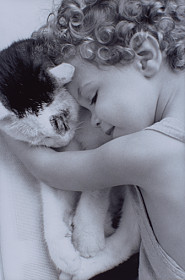Frequently Asked Questions
 What will happen during your visit to my home?
What will happen during your visit to my home?
No white coats. No scrubs. We arrive in regular clothes to minimize any association with a clinic. After our arrival to your home, there will be authorization forms to complete. Frequently, families feel this is the easiest time to provide payment, as well. We move at your pace. Only when you are ready, we will proceed.
What will the euthanasia procedure entail?
First, your companion animal will be administered a sedative to provide a stress and pain free experience. After the sedation has taken full effect, for most patients, a catheter will be inserted into a vein of the front or back leg. This catheter assures secure venous access for the procedure. Finally, whenever you are ready, the euthanasia solution is administered through the IV catheter. The breath and heart rate gradually slow to a stop, usually within seconds. We will listen with a stethoscope several times to make sure the heart has indeed stopped.
How do I know when the time is right?
The decision to help your cat or dog transition is never an easy one. Furthermore, it is so very personal. The first question has to be: Do you feel more drawn to providing the generous care of hospice? Or, do you feel more comfortable with the gift of euthanasia? There is no wrong answer. Trust your heart. If your companion animal is experiencing severe signs of distress that include difficulty breathing, shock or severe pain, gentle euthanasia would provide immediate relief from that profound suffering. However, many of our aged companions do not experience any of those severe signs of distress. Their distress is more subtle. Maybe they have lost mobility due to chronic pain they are experiencing. The pain could be from arthritis or cancer. As a result of losing mobility, they experience incontinence, develop pressure sores and infections. With this, comes the loss of dignity. In the situation of more chronic conditions like debilitating pain, cancer, chronic kidney disease, just to name a few, the decision of “when” can be a very difficult one. Here are a couple of links to questionnaires that can be helpful in making the decision:
The Ohio State University VMC Questionnaire
We are here for you. Please do not hesitate to reach out to discuss your personal journey.
What Body Care options do I have?
Most families elect to have their pet memorialized either through cremation or burial. We would be honored to make arrangements for dignified and reverent cremation. Our crematory partners are leaders in the industry who only offer 100% Private Cremation (No partitioned privates) or communal. We have toured their facilities so you can rest assured your Beloved is in respectful hands.
Burial is another beautiful way to memorialize our pets. It can be done at a pet cemetery or on your own property. Check with your local county about laws governing private burial. If considering private burial, consider calling 8-1-1 prior to any digging project. To prevent the attraction of wild animals, placement should be at least 3-4 feet below the ground’s surface, wrapped in plastic and placed in a pet casket/wood or metal box. Placing large stones or a heavy object over top the grave is another deterrent for curious wild animals.
If I wish for a 100% private cremation, will my pet be alone in the cremation chamber?
Yes. 100% alone. This is different than a “Partitioned” private which is sometimes referred to as an “Individual” or “Private” cremation. 100% Private cremation is referred to a private or individual cremation, as well! This can be very confusing for everyone not familiar with the pet cremation industry. We would be honored to make arrangements for a 100% Private cremation for your companion animal. We will bring their ashes home to you.
A “Partitioned” cremation is when more than one pet is placed in the cremation chamber at a time. They are separated by space, bricks or a small partition. Ashes are returned to the family. Given the nature of cremation, active co-mingling of ashes occur during this process.
What should I tell my children?
This can be especially difficult for children, particularly if their friend has been with them the entirety of their lives. Learning about the cycle of life and death is a very valuable lesson that everyone has to experience at some point. Only you know when it is the best time to teach that lesson to your children. Allowing them to grieve and providing them lots of support is key. Euthanasia provides a wonderful opportunity for us to teach our children lessons of compassion, love and strength.
Encouraging them to celebrate the lovely life that their animal friend experienced can be a helpful way to deal with the sadness. Planting a garden or tree dedicated to their pet, drawing pictures or collecting photos of their pet to create a special album or writing a letter to their companion animal are beautiful activities that children may enjoy.
Snort’s Special Gift by Suzann Yue, Jasper’s Day by Marjorie Blaine Parker,Goodbye Mousie by Robie Harris, Love That Dog by Sharon Creech and Saying Goodbye to Lulu by Corinne Demas are a few books helpful for children that may be coping with the loss of a companion animal.
What do I need to do to prepare for your arrival?
Decide where and how you want the procedure to take place. Outside in a favorite garden or sleeping area are popular locations. Do you want your animal companion to lay on a special blanket or bed? Who wants to be present for the euthanasia? Decide on a body care option: private cremation, memorial cremation, cemetery burial or home burial.
